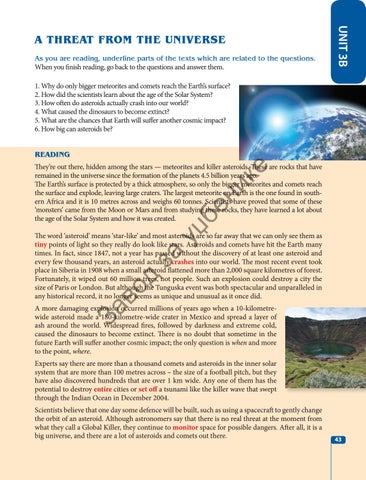As you are reading, underline parts of the texts which are related to the questions. When you finish reading, go back to the questions and answer them.
UNIT 3B
A THREAT FROM THE UNIVERSE
1. Why do only bigger meteorites and comets reach the Earth’s surface? 2. How did the scientists learn about the age of the Solar System? 3. How often do asteroids actually crash into our world? 4. What caused the dinosaurs to become extinct? 5. What are the chances that Earth will suffer another cosmic impact? 6. How big can asteroids be? READING
уџ бе
ни ке
They’re out there, hidden among the stars — meteorites and killer asteroids. These are rocks that have remained in the universe since the formation of the planets 4.5 billion years ago. The Earth’s surface is protected by a thick atmosphere, so only the bigger meteorites and comets reach the surface and explode, leaving large craters. The largest meteorite on Earth is the one found in southern Africa and it is 10 metres across and weighs 60 tonnes. Scientists have proved that some of these ‘monsters’ came from the Moon or Mars and from studying these rocks, they have learned a lot about the age of the Solar System and how it was created.
во
д
за
The word ‘asteroid’ means ‘star-like’ and most asteroids are so far away that we can only see them as tiny points of light so they really do look like stars. Asteroids and comets have hit the Earth many times. In fact, since 1847, not a year has passed without the discovery of at least one asteroid and every few thousand years, an asteroid actually crashes into our world. The most recent event took place in Siberia in 1908 when a small asteroid flattened more than 2,000 square kilometres of forest. Fortunately, it wiped out 60 million trees, not people. Such an explosion could destroy a city the size of Paris or London. But although the Tunguska event was both spectacular and unparalleled in any historical record, it no longer seems as unique and unusual as it once did.
За
A more damaging explosion occurred millions of years ago when a 10-kilometrewide asteroid made a 180-kilometre-wide crater in Mexico and spread a layer of ash around the world. Widespread fires, followed by darkness and extreme cold, caused the dinosaurs to become extinct. There is no doubt that sometime in the future Earth will suffer another cosmic impact; the only question is when and more to the point, where. Experts say there are more than a thousand comets and asteroids in the inner solar system that are more than 100 metres across – the size of a football pitch, but they have also discovered hundreds that are over 1 km wide. Any one of them has the potential to destroy entire cities or set off a tsunami like the killer wave that swept through the Indian Ocean in December 2004. Scientists believe that one day some defence will be built, such as using a spacecraft to gently change the orbit of an asteroid. Although astronomers say that there is no real threat at the moment from what they call a Global Killer, they continue to monitor space for possible dangers. After all, it is a big universe, and there are a lot of asteroids and comets out there.
43







































